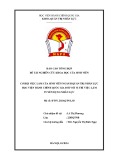
Hindawi Publishing Corporation
Journal of Inequalities and Applications
Volume 2011, Article ID 183297, 15 pages
doi:10.1155/2011/183297
Research Article
Optimality Conditions of Vector Set-Valued
Optimization Problem Involving Relative Interior
Zhiang Zhou1, 2
1College of Sciences, Shanghai University, Shanghai 200444, China
2Department of Applied Mathematics, Chongqing University of Technology, Chongqing 400054, China
Correspondence should be addressed to Zhiang Zhou, zhi ang@163.com
Received 26 October 2010; Revised 25 December 2010; Accepted 22 January 2011
Academic Editor: Sin E. Takahasi
Copyright q2011 Zhiang Zhou. This is an open access article distributed under the Creative
Commons Attribution License, which permits unrestricted use, distribution, and reproduction in
any medium, provided the original work is properly cited.
Firstly, a generalized weak convexlike set-valued map involving the relative interior is introduced
in separated locally convex spaces. Secondly, a separation property is established. Finally,
some optimality conditions, including the generalized Kuhn-Tucker condition and scalarization
theorem, are obtained.
1. Introduction
In mathematical programming, set-valued optimization is a very important topic. Since
the 1980s, many authors have paid attention to it. Some international journals such
as Set-Valued and Variational Analysis original name: Set-Valued Analysiswere also
established. Theories and applications are widely developed. Rong and Wu 1,Li2,
and Yang 3and Yang 4introduced cone convexlikeness, subconvexlikeness, generalized
subconvexlikeness, and nearly subconvexlikeness, respectively. In these generalized convex
set-valued maps, it is clear that nearly subconvexlikeness is the weakest. We find that, in the
above-mentioned papers, the convex cone has a nonempty topological interior. However,
it is possible that the topological interior of the convex cone is empty. For instance, if
C{r, 0|r≥0}⊆R2, then the topological interior of Cis empty. In order to study some
optimization problems which the convex cone has empty topological interior, we have to
weaken the concept of the topological interior. Rockafellar 5introduced the relative interior,
which is the generalization of the topological interior. Based on the relative interior, Frenk and
Kassay 6,7obtained Lagrangian duality theorems and Bot et al. 8studied strong duality
for generalized convex optimization problems. Borwein and Lewis 9introduced the quasi-
relative interior. Bot et al. 10studied the regularity conditions via quasi-relative interior in

2 Journal of Inequalities and Applications
convex programming. However, we find that only a few papers 11,12are about set-valued
optimization involving the relative interior. In this paper, we will further study set-valued
optimization problems involving relative interior.
This paper is organized as follows. In Section 2, we give some preliminaries. In
Section 3, a kind of generalized weak convexlike set-valued map involving relative interior
is introduced, and a separation property is established. In Section 4, some optimality
conditions, including the generalized Kuhn-Tucker condition and scalarization theorem, are
obtained.
2. Preliminaries
Let X,Y,andZbe three separated locally convex spaces, and let 0 denote the zero element
for every space. Let Kbe a nonempty subset of Y. The generated cone of Kis defined as
cone K{λa |a∈K, λ ≥0}.AconeK⊆Yis said to be pointed if K∩−K{0}.Acone
K⊆Yis said to be nontrivial if K/
{0}and K/
Y.
Let Y∗and Z∗stand for the topological dual space of Yand Z, respectively. From
now on, let Cand Dbe nontrivial pointed closed-convex cones in Yand Z, respectively. The
topological dual cone Cand strict topological dual cone Ciof Care defined as
Cy∗∈Y∗|y, y∗
0,∀y∈C,
Ciy∗∈Y∗|y, y∗>0,∀y∈C\{0},
2.1
where y, y∗denotes the value of the linear continuous functional y∗at the point y.The
meanings of Dand Diare similar.
Let Kbe a nonempty subset of Y.WedenotebyclK, int K,andaffKthe closed hull,
topological interior, and affine hull of K, respectively.
Definition 2.1 see 11,13.LetKbe a subset of Y. The relative interior of Kis the set
riKx∈K|there exists U, a neighborhood of x, such that U∩affK⊆K.2.2
Now, we give some basic properties about the relative interior.
Lemma 2.2. Let Kbe a subset of Y.Letk0∈K,k∈ri K,α∈R,andλ∈0,1.Then,
aαri KriαK;
bif Kis convex, then
1−λk0λk∈ri K. 2.3
Proof. aSince αaffKaffαK, it is clear that αri KriαK;
bsince k∈ri K,thereexistsV, a neighborhood of 0, such that
kV∩affK⊆K. 2.4

Journal of Inequalities and Applications 3
By 2.4,wehave
λkλV ∩λaffK⊆λK. 2.5
It follows from 2.5that
1−λk0λkλV ∩1−λk0λaffK⊆1−λk0λK. 2.6
It is clear that
1−λk0λaffKaffK. 2.7
Since Kis convex, we have
1−λk0λK ⊆K. 2.8
By 2.6,2.7,and2.8,weobtain
1−λk0λkλV ∩affK⊆K, 2.9
which implies that
1−λk0λk∈ri K. 2.10
Remark 2.3. By Lemma 2.2,ifKis a convex cone, then ri K∪{0}is a convex cone.
Lemma 2.4. If Kis a convex cone of Y,then
Kri K⊆ri K. 2.11
Proof. If ri Kφ, it is clear that the conclusion holds. If ri K/
φ,wehave
Kri K21
2K1
2ri K⊆2riKri 2Kri K, 2.12
where Lemma 2.2bis used in the first inclusion relation and Lemma 2.2ais used in the
second equality.
Lemma 2.5 see 14,15.Let Wbe a linear topological space and w∗be a linear functional on
W.w∗is continuous if and only if H{w|w, w∗0,w ∈W}is closed. If His not closed, H
is dense in W.
We will close this section by giving a separation theorem based on the relative interior.

4 Journal of Inequalities and Applications
Lemma 2.6 see 11.Let K⊆Ybe a closed-convex set with ri K/
φ.If0/∈ri K, then there exists
y∗∈Y∗\{0}such that k, y∗≥0for each k∈K.
Remark 2.7. The following example will show that the closeness of Kcannot be deleted in
Lemma 2.6.
Example 2.8. Let Ybe an infinite-dimensional normed space and k∗be a non-continuous
linear functional on Y.Kis defined as
K{k|k, k∗1,k∈Y}.2.13
Since affKK, it is clear that 0 /∈ri KK.ByLemma 2.5,Kis not closed and cl KY.
Therefore, for any y∗∈Y∗\{0},y
∗cannot separate 0 and K.
Remark 2.9. Example 2.8 shows that, even if Kis a convex subset of Y, the expression that
ricl Kri Kdoes not hold generally.
3. Separation Property
From now on, we suppose that ri C/
φand ri D/
φ.LetAbe a nonempty subset of Xand
F:A→2Ybe a set-valued map on A.WriteFA∪x∈AFx.
Definition 3.1 see 1.LetAbe a nonempty subset of X.Aset-valuedmapF:A→2Yis
called C-convexlike on Aif the set FACis convex.
In 2,3,16,17, when int C/
φ,C-subconvexlike map and generalized C-
subconvexlike map were introduced, respectively. The following two definitions are
generalizations of C-subconvexlike map and generalized C-subconvexlike map, respectively.
Definition 3.2 see 12.LetAbe a nonempty subset of X.Aset-valuedmapF:A→2Yis
called C-weak convexlike on Aif the set FAri Cis convex.
Definition 3.3 see 12.LetAbe a nonempty subset of X.Aset-valuedmapF:A→2Yis
called generalized C-weak convexlike on Aif the set cone FAri Cis convex.
Remark 3.4. By 12, Theorems 3.1 and 3.2, we have the following implications:
C-convexlikeness ⇒C-weak convexlikeness ⇒generalized C-weak convexlikeness.
However, the following two examples show that the converse of the above
implications is not generally true.
Example 3.5. Let XYR2,C{y1,0|y1≥0},andA{1,0,0,2}.Theset-valued
map F:A→2Yis defined as follows:
F1,0y1,y
2|1<y
1≤2,0≤y2≤1∪{1,0,1,1},
F0,2y1,y
2|1<y
1≤2,1≤y2≤2∪{1,2,1,1}.
3.1

Journal of Inequalities and Applications 5
It is clear that FAri Cis convex and FACis not convex. Therefore, Fis C-weak
convexlike on A. However, Fis not C-convexlike on A.
Example 3.6. Let XYR2,C{y1,0|y1≥0},andA{1,0,0,2}.Theset-valued
map F:A→2Yis defined as follows:
F1,0y1,y
2|y1≥0,1≤y2≤−y12,
F0,2y1,y
2|y1≥1,0≤y2≤−y12.
3.2
It is clear that cone FAri Cis convex and FAri Cis not convex. Therefore, Fis
generalized C-weak convexlike on A. However, Fis not C-weak convexlike on A.
Now, we consider the following two systems.
System 1: There exists x0∈Asuch that Fx0∩−ri C/
φ.
System 2: There exists y∗∈C\{0}such that y, y∗≥0,for all y∈FA.
Theorem 3.7. Let Abe a nonempty subset of X.
iSuppose that F:A→2Yis generalized C-weak convexlike on Aand riclcone FA
ri C ricone FAri C/
φ. If System 1 has no solution, then System 2 has solution.
iiIf y∗∈Ciis a solution of System 2, then System 1 has no solution.
Proof. iFirstly, we assert that 0 /∈cone FAri C. Otherwise, there exist x0∈A, α ≥0such
that 0 ∈αFx0ri C.
Case 1. If α0, then 0 ∈ri C. Thus, there exists U, a neighborhood of 0, such that
U∩affC⊆C. 3.3
Without loss of generality, we suppose that Uis symmetric. It follows from 3.3that
U∩−affC⊆−C.3.4
It is clear that affCis a linear subspace of Y. Therefore, affC−affC.By3.4,wehave
U∩affC⊆−C.3.5
By 3.3and 3.5,weobtain
U∩affC⊆C∩−C.3.6
Since Cis nontrivial, there exists c∈C\{0}. By the absorption of U,thereexistsλ,a
sufficiently small positive number, such that
λc∈U∩affC⊆C∩−C,3.7
which contradicts that Cis pointed.


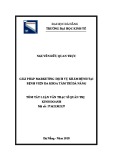
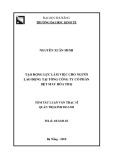
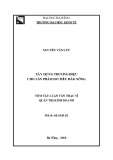
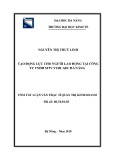


![Hình ảnh học bệnh não mạch máu nhỏ: Báo cáo [Năm]](https://cdn.tailieu.vn/images/document/thumbnail/2024/20240705/sanhobien01/135x160/1985290001.jpg)
